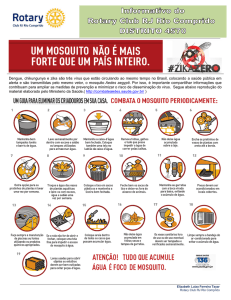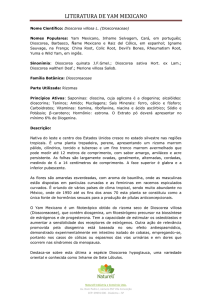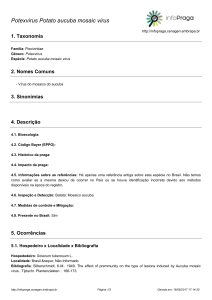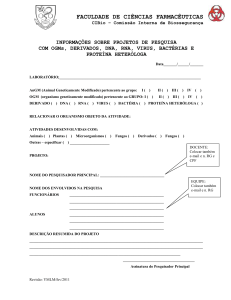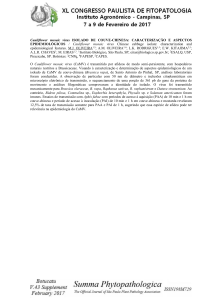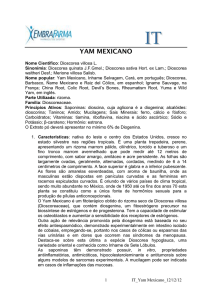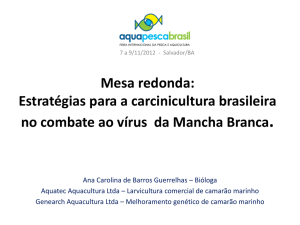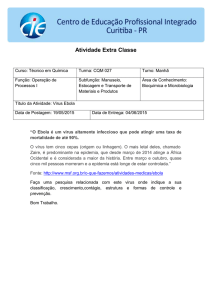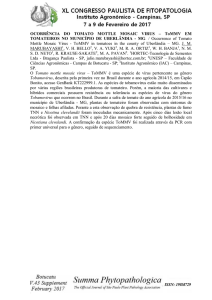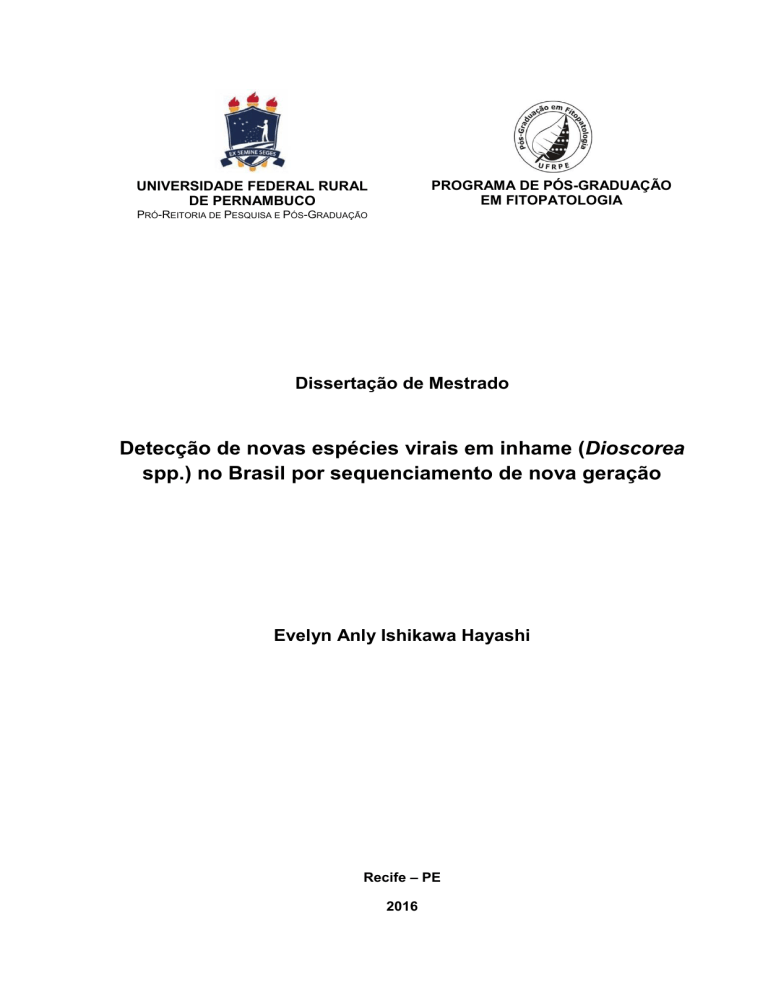
PROGRAMA DE PÓS-GRADUAÇÃO
EM FITOPATOLOGIA
UNIVERSIDADE FEDERAL RURAL
DE PERNAMBUCO
PRÓ-REITORIA DE PESQUISA E PÓS-GRADUAÇÃO
Dissertação de Mestrado
Detecção de novas espécies virais em inhame (Dioscorea
spp.) no Brasil por sequenciamento de nova geração
Evelyn Anly Ishikawa Hayashi
Recife – PE
2016
EVELYN ANLY ISHIKAWA HAYASHI
DETECÇÃO DE NOVAS ESPÉCIES VIRAIS EM INHAME (DIOSCOREA SPP.) NO
BRASIL POR SEQUENCIAMENTO DE NOVA GERAÇÃO
Dissertação apresentada ao Programa de PósGraduação em Fitopatologia da Universidade
Federal Rural de Pernambuco, como parte dos
requisitos para obtenção do título de Mestre em
Fitopatologia.
COMITÊ DE ORIENTAÇÃO:
Orientador: Prof. Dr. Gilvan Pio Ribeiro (UFRPE)
Co-Orientador: Prof. Dr. Tatsuya Nagata (UnB)
Co-Orientadora: Dra. Genira Pereira de Andrade (UFRPE)
RECIFE-PE
FEVEREIRO-2016
Ficha catalográfica
H413d
Hayashi, Evelyn Anly Ishikawa
Detecção de novas espécies virais em inhame (Dioscorea
spp.) no Brasil por sequenciamento de nova geração / Evelyn
Anly Ishikawa Hayashi. – Recife, 2016.
59 f. : il.
Orientador: Gilvan Pio Ribeiro.
Dissertação (Mestrado em Fitopatologia) – Universidade
Federal Rural de Pernambuco, Departamento de Agronomia,
Recife, 2016.
Referências.
1. PCR 2. NGS 3. Secoviridae 4. Closteroviridae 5. Foveavirus
I. Ribeiro, Gilvan Pio, orientador II. Título
CDD 632
DETECÇÃO DE NOVAS ESPÉCIES VIRAIS EM INHAME (DIOSCOREA SPP.) NO
BRASIL POR SEQUENCIAMENTO DE NOVA GERAÇÃO
EVELYN ANLY ISHIKAWA HAYASHI
Dissertação defendida e aprovada pela Banca Examinadora em: 29/ 02 /2016.
ORIENTADOR:
Prof. Dr. Gilvan Pio Ribeiro (UFRPE)
EXAMINADORES:
Profa. Dra. Elineide Barbosa de Sousa (UFRPE)
Dra. Genira Pereira de Andrade (UFRPE)
RECIFE-PE
FEVEREIRO-2016
Aos meus pais Elna e Júlio, que me apoiaram
e acreditaram no meu potencial.
DEDICO
iv
AGRADECIMENTOS
Agradeço primeiramente a Deus pela oportunidade de crescimento e aprimoramento
profissional e pessoal. Por ter me dado a força e sabedoria necessária para enfrentar os
desafios ao longo desses dois anos e por me fazer entender que na vida não acumulamos
derrotas e sim oportunidades de aprender novas lições para nos tornar pessoas cada vez
melhores;
À Universidade Federal Rural de Pernambuco (UFRPE), em especial ao Programa de PósGraduação em Fitopatologia (PPGF) pela oportunidade de realizar o Curso de Mestrado e aos
professores pelos ensinamentos;
Ao Conselho Nacional de Desenvolvimento Científico e Tecnológico (CNPq) e à Fundação
de Amparo à Ciência e Tecnologia do Estado de Pernambuco (Facepe), pelo apoio recebido;
À Universidade de Brasília (UnB), por oferecer o suporte e espaço necessários para a
execução do trabalho;
Ao professor Dr. Gilvan Pio Ribeiro e à Dra. Genira Pereira de Andrade, pelo apoio,
paciência, conselhos e ensinamentos transmitidos;
Ao professor Dr. Tatsuya Nagata, por ter me acolhido como parte da sua equipe. Pela
paciência, confiança, conselhos, incentivo profissional e principalmente pelos conhecimentos
adquiridos;
À minha família, por incentivar e apoiar minhas decisões, sejam elas quais forem. Por serem o
meu porto seguro nos melhores e piores momentos.
Ao meu namorado Rubens Jr. pelo apoio e paciência incondicionais. Pelas noites mal
dormidas ouvindo minhas lamentações e pelas incontáveis palavras de carinho e incentivo
durante esses dois anos;
Aos membros do Laboratório de Microscopia Eletrônica da UnB, que quer seja de maneira
direta ou indireta fizeram este trabalho possível e a minha estadia em Brasília mais agradável;
À professora Dra. Rosana Blawid, pelo companheirismo, apoio, paciência, conselhos,
ensinamentos e principalmente pela amizade e carinho.
Às minhas amigas do PPGF (Daniele Barbosa, Carmem Abade, Gabriela Calderón, Gerusa
Santos, Michele Santiago e Soraya Silva), pelos ótimos momentos, amizade e
companheirismo que, sem dúvida, me ajudaram nesta caminhada.
SUMÁRIO
Página
AGRADECIMENTOS .................................................................................................. iv
RESUMO GERAL ........................................................................................................ vi
GENERAL ABSTRACT.............................................................................................. vii
CAPÍTULO I – Introdução Geral................................................................................. 1
Aspectos gerais da cultura do inhame e importância econômica............................2
Vírus que infectam Dioscorea spp. ............................................................................3
Família Closteroviridae................................................................................................4
Família Secoviridae......................................................................................................6
Gênero Foveavirus (Família Betaflexiviridae)...........................................................8
Sequenciamento de Nova Geração na Virologia Vegetal.........................................9
Referências Bibliográficas............................................................................................12
CAPÍTULO II - Detection of a new virus belonging to Closteviridade family in yam
of Brazil………………………………………………………………………………. 23
Abstract ......................................................................................................................... 23
Resumo .......................................................................................................................... 24
References...................................................................................................................... 28
CAPÍTULO III - Complete genome sequence of a new secovirus infecting on
Dioscorea plant.............................................................................................................. 31
Abstract ......................................................................................................................... 33
Resumo .......................................................................................................................... 33
References...................................................................................................................... 36
CAPÍTULO IV - Complete genome sequence of a new foveavirus infecting on
Dioscorea plant……………………………………………………………………...…40
Abstract……………………....………………………………………………………...42
Resumo………….……………………………………………………....……………...43
References………………….....………………………………………………………..46
CONCLUSÕES GERAIS …………………………….......….......…………………..50
vi
RESUMO GERAL
O inhame (Dioscorea spp.) apresenta importante papel socioeconômico nas regiões
tropicais e subtropicais da Ásia, África e Américas incluindo o Caribe. No Brasil, se constitui
uma expressiva fonte de renda e alimento para as populações locais e agricultura familiar,
principalmente na região Nordeste do país. A produtividade da cultura é bastante afetada,
tanto por fatores abióticos, como por agentes bióticos, entre os quais fungos, nematoides e
vírus. Doenças causadas por vírus são importantes, pois a propagação vegetativa do inhame
proporciona o acúmulo e disseminação desses patógenos em cultivos sucessivos. Até o
momento, os vírus relatados nesta cultura pertencem a nove gêneros: Aureusvirus,
Badnavirus, Carlavirus, Comovirus, Cucumovirus, Fabavirus, Macluravirus, Potexvirus e
Potyvirus. No presente trabalho objetivou-se analisar, através do Sequenciamento de Nova
Geração (Next Generation Sequencing - NGS), as diferentes espécies virais que infetam o
inhame em plantios localizados nos estados de Pernambuco e Paraíba e no Distrito Federal.
Amostras de tecido foliar de D. rotundata e D. alata foram submetidas a purificação viral
parcial, o RNA total foi extraído e submetido ao NGS. As leituras nucleotídicas obtidas foram
montadas utilizando o pragrama CLC Genomics Workbench 6.5 e os contigs utilizando o
programa Geneious. Por meio dos dados obtidos por NGS foi possível a detecção de três
espécies virais novas relatadas neste trabalho. Foi sequenciado o genoma completo de duas
espécies, uma pertencente à família Secoviridae, que recebeu o nome Dioscorea virus S
(DVS), e outra ao gênero Foveavirus da família Betaflexiviridae, denominada de Dioscorea
virus F (DVF). Para a terceira espécie descrita, pertencente à família Closteroviridae, foi feita
apenas a detecção viral nas amostras coletadas e a proposição do nome Dioscorea virus C
(DVC).
Palavras-chave: PCR, NGS, Secoviridae, Closteroviridae, Foveavirus
vii
GENERAL ABSTRACT
The yam (Dioscorea spp.) has an important socio-economic role in tropical and
subtropical regions of Asia, Africa and the Americas including the Caribbean. In Brazil, it is a
significant source of income and food for the local populations and family agriculture,
especially in the Northeast region of the country. The crop yield is very affected by both
abiotic factors and biotic agents, including fungi, nematodes and viruses. Diseases caused by
viruses are important because the vegetative propagation of yam provides the accumulation
and spread of these pathogens on successive crops. To date, the reported viruses in this crop
belong to nine genera: Aureusvirus, Badnavirus, Carlavirus, Comovirus, Cucumovirus,
Fabavirus, Macluravirus, Potexvirus and Potyvirus. The objective of the present work was to
analyze, through the Next Generation Sequencing (NGS), different viral species that infect the
yam in fields located in the states of Pernambuco and Paraíba and in the Federal District. Leaf
tissue samples of D. rotundata and D. alata were subjected to partial virus purification, the
total RNA was extracted and submitted to NGS. The nucleotide reads obtained were
assembled using CLC Genomics Workbench 6.5 program and the contigs using Geneious
program. Based on the data obtained from NGS it was possible to detect three new virus
species reported in this work. It was sequenced the complete genome of two new species, one
belonging to the family Secoviridae, with the proposed name Dioscorea virus S (DVS), and
another to Foveavirus genus of the family Betaflexiviridae, called Dioscorea virus F (DVF).
For the third species described, belonging to the family Closteroviridae, it was done only the
viral detection in the collected samples and proposed the name Dioscorea virus C (DVC).
Keywords: PCR, NGS, Secoviridae, Closteroviridae, Foveavirus
CAPÍTULO I
Introdução geral
2
DETECÇÃO DE NOVAS ESPÉCIES VIRAIS EM INHAME (DIOSCOREA SPP.) NO
BRASIL POR SEQUENCIAMENTO DE NOVA GERAÇÃO
INTRODUÇÃO GERAL
Aspectos gerais da cultura do inhame e importância econômica
A planta de inhame é uma angiosperma monocotiledônea pertencente à família
Dioscoreaceae, da qual o gênero Dioscorea é composto por cerca de 600 espécies diferentes
distribuídas principalmente em áreas subtropicais ou tropicais da África, Ásia, Américas e
Oceania (NGO-NGWE et al., 2014). Dentre as espécies de inhame, apenas dez fornecem
produtos comestíveis: Dioscorea alata L., D. rotundata Poir, D. cayenensis Lam., D.
bulbifera L., D. esculenta Burk., D. opposita Thunb., D. japonica Thunb., D. nummularia
Lam., D. pentaphylla L. e D. trifida L. (SARTIE; ASIEDU; FRANCO, 2012).
Acredita-se que o gênero Dioscorea se dispersou pelo mundo no final do período
Cretáceo. As principais regiões para onde houve a dispersão de muitas espécies foram as
Américas, África, Madagascar, Sul e Sudeste Asiático e Oceania. As espécies D. esculenta e
D. alata originaram-se no Sudeste Asiático, já D. cayenensis tem sua origem na África e D.
trifida na América do Sul. As demais espécies cultivadas de inhame tiveram suas origens na
África e Ásia (SIQUEIRA, 2011).
O inhame é a quarta cultura tuberosa mais importante do mundo em termos
econômicos, estando atrás apenas da batata (Solanum tuberosum L.), mandioca (Manihot
esculenta Crantz) e batata-doce (Ipomoea batatas (L.) Poir.). A África Ocidental é a principal
região produtora de inhame no mundo com aproximadamente 62 milhões de toneladas (91%
da produção mundial) em 2014, correspondendo a uma área plantada de cerca sete milhões de
hectares. Na América do Sul, a Colômbia é a maior produtora. O Brasil fica em segundo lugar
produzindo 247 mil toneladas em uma área plantada de quase 26 mil hectares (FAO, 2014)
Devido ao elevado teor de amido, a túbera de inhame tem alto valor nutritivo,
desempenhando papel fundamental na alimentação humana em continentes como a Ásia,
África e Américas, incluindo o Caribe (MAMBOLE et al., 2014; SEAL et al., 2014). A
cultura do inhame possui grande importância para a economia local de vários países
subdesenvolvidos, tanto pela geração de empregos quanto pela comercialização de seu
produto seja in natura para o consumo local ou na forma de produtos medicinais como fonte
de antioxidantes e também na indústria farmacêutica na extração de metabólitos secundários
(GHOSH et al., 2013; NYABOGA et al., 2014).
3
No Brasil, o inhame tem elevado valor socioeconômico na região Nordeste, uma vez
que a túbera está intimamente ligada aos hábitos alimentares da população tendo a produção,
principalmente, advinda da agricultura familiar voltada para o consumo interno (OLIVEIRA;
FREITAS NETO; SANTOS, 2001). O estado de Pernambuco se destaca como maior produtor
e grande consumidor de inhame, fator positivo para agricultura familiar e consequentemente o
desenvolvimento rural, uma vez que, além dos empregos diretos, a cadeia produtiva da cultura
também é geradora de empregos indiretos envolvidos no armazenamento, transporte e
comercialização da túbera (OLIVEIRA et al., 2012).
Apesar de sua importância socioeconômica para muitas regiões do mundo, a cultura
do inhame ainda encontra várias limitações em relação a sua produtividade. Isto se deve
principalmente à falta de investimentos em tecnologias e pesquisas com abordagens
bioquímicas e moleculares, como também ao manejo inadequado da cultura, com a utilização
de técnicas agronômicas defasadas (SASKI et al., 2015).
O cultivo do inhame é afetado significativamente pela elevada incidência e severidade
de doenças bióticas e abióticas, com destaque para as causadas por fungos e nematoides, para
as quais se medidas preventivas não sejam aplicadas, representam um importante fator
limitante para a produção (OLIVEIRA; MOURA; MAIA 2005). As viroses, a Queima ou
Pinta-preta (Curvularia eragostides), Podrião-verde (Penicillium sclerotigenum) e as
nematoses Casca-preta (Pratylenchus coffea e Scutellonema bradys) e Meloidoginose
(Meloidogyne spp.) são as principais doenças que afetam a cultura, causando em grandes
perdas, tanto no campo quanto no transporte e armazenamento (ANDRADE, 2007; SANTOS
et al., 2009; SIQUEIRA, 2011).
Vírus que infectam Dioscorea spp.
As viroses são de particular importância para a cultura do inhame, pois a floração e
emissão de sementes são raras, sendo utilizada comercialmente a propagação vegetativa por
meio de pequenas túberas ou pedaços das mesmas, favorecendo o acúmulo e perpetuação dos
vírus em plantios sucessivos (SEAL; MULLER, 2007; SILVA et al., 2015).
As espécies virais que infectam Dioscorea spp., relatadas até o momento, pertencem a
nove gêneros: Aureusvirus – Yam spherical virus (YSV); Badnavirus - Dioscorea bacilliform
viruses (DBV) e Dioscorea bacilliform alata virus (DBALV); Carlavirus – Hop latent virus
(HpLV); Comovirus – Dioscorea mottle virus (DmoV); Cucumovirus – Cucumber mosaic
virus (CMV); Fabavirus – Broad bean wilt virus 2 (BBWV-2); Macluravirus – Chinese yam
4
necrotic mosaic virus (CYNMV); Potexvirus – Yam virus X (YVX); Potyvirus – Yam mosaic
virus (YMV) e Yam mild mosaic virus (YMMV). No entanto, a diversidade de vírus que
infectam a planta de inhame permanece largamente inexplorado. O impacto das infecções
virais no rendimento e qualidade das túberas pode ser uma importante ameaça para a
sustentabilidade desta cultura. Por exemplo, o cultivo de D. trifida está passando por um forte
declínio no Caribe devido a sua alta susceptibilidade às potyviroses (MAMBOLE et al., 2014;
SEAL et al., 2014).
Estudos apontam que os badnavírus causam as viroses do inhme que mais
prevalessem no mundo (SEAL et al., 2014). Entretanto, os potyvírus que ocorrem nesta
cultura são mais estudados (ENI et al., 2010), a exemplo do YMV, tido como a espécie viral
de maior importância econômica, podendo causar uma variedade de sintomas, incluindo
mosaico, clorose, deformação foliar e nanismo (SILVA et al., 2015).
No Brasil, duas espécies importantes do gênero Potyvirus foram relatadas, o YMV e o
YMMV (FILHO et al., 2013). O YMV ocorre comumente em plantas pertencentes ao
complexo D. cayennensis-D. rotundata e com menor incidência e importância em D. alata.
As plantas de D. alata estudadas em diferentes áreas da Nigéria apresentaram
infecção viral (ODU et al., 2006). Dentre os badnavírus, o DBALV é o mais difundido no
mundo, sendo detectado também no Brasil em quase todas as áreas produtoras de inhame
causando infecção simples ou mista podendo induzir distorção foliar e clorose (UMBER et
al., 2014).
Infecções mistas de vírus têm sido relatadas na cultura de inhame como, por exemplo,
a ocorrência de YMV e YMMV (MOHAMED, N.A.; MANTELL, S.H, 1976). Em condições
de campo, este tipo de interação dificulta a identificação das espécies virais causadoras das
doenças, além de aumentar a intensidade de sintomas resultante da ação sinérgica entre vírus,
com maior reflexo na produtividade.
Família Closteroviridae
Membros pertencentes a família Closteroviridae possuem os maiores e mais
complexos genomas de fita simples de RNA, podendo variar de tamanho de 15-20 kb
(FAYEZ; MAHMOUD, 2011). Os closterovírus (nome genérico para os vírus da família) são
oficialmente divididos em três gêneros (Closterovirus, Crinivirus e Ampelovirus) e a inclusão
de um quarto gênero (Velarivirus) foi proposto recentemente (KISS; MEDINA; FALK, 2013;
ITO; SATO; SUZAKI, 2015). Membros da família possuem partículas virais flexuosas
5
filamentosas com 700-2.000 nm de comprimento e 12 nm de diâmetro, podendo o genoma ser
mono ou multipartido (FAYEZ; MAHMOUD, 2011).
Os vírus do gênero Closterovirus possuem genoma monopartido com tamanho variado
entre 15,5 a 19,3 Kb e são transmitidos por diversos afídeos. O gênero Crinivirus engloba os
vírus com genoma bipartido ou tripartidos e são transmitidos exclusivamente por moscasbranca pertencentes aos gêneros Bemisia e Trialeurodes. Espécies do gênero Ampelovirus
possuem genoma monopartido com 16.9 – 19.9 Kb de tamanho, sendo transmitidos por
cochonilhas. O gênero Velarivirus é formado por espécies anteriormente incluídos no gênero
Ameplovirus que representam um clado diferente na árvore filogenética (ISOGAI et al., 2013;
KISS; MEDINA; FALK, 2013). Embora o número e a posição relativa das fases abertas de
leitura, ou em inglês “Open Read Frames” (ORFs), possam mudar de espécies para espécie, a
organização genômica é a mesma. Todos os cloterovírus possuem dois genes conservados,
incluindo um que codifica proteinas associadas com a replicação (OFRs 1a e 1b) e um
quíntuplo “gene block” que codificam proteínas que constituem a partícula viral ou que estão
envolvidas no movimento célula-a-célula ou outros processos biológicos (Fig. 1) (KISS;
MEDINA; FALK, 2013; RUBIO; GUERRI; MORENO, 2013).
A família Closteroviridae inclui espécies virais de grande importância agronômica.
Uma dos mais conhecidas é o Citrus triteza virus (CTV), pertencente ao gênero
Closterovirus, responsável por epidemias devastadoras que dizimaram plantações inteiras de
citros e mudou o curso das indústrias cítricas do mundo. Dependendo da combinação portaenxerto-estirpe viral-enxerto, o CTV induz três síndromes distintas: rápido declínio seguido
de morte da planta, canelura e mudas amareladas. Medidas de controle para o CTV incluem:
programa de quarentena, eliminação de plantas infectadas, uso de porta-enxertos tolerantes ou
proteção cruzada com isolados menos agressivos (MORENO et al., 2008; BAR-JOSEPH;
MAWASSI, 2013; OWEN et al., 2014). Na videira, diferentes espécies pertencentes à família
Closteroviridae causam a doença viral de maior importância econômica que afeta a cultura,
denominada de “Grapevine leafroll disease” (LUNDEN; QIU, 2011; AL RWAHNIH et al.,
2012).
6
Figura 1. Representação da organização genômica típica dos membros da família
Closteroviridae. As ORFs 1a e 1b codificam proteínas relacionadas à replicação viral. O
quíntuplo ‘gene block’ (p6, MP, p64, p20 e p21) que codificam proteínas envolvidas no
movimento célula-a-célula do vírus e na interação da partícula viral com o hospedeiro. CP e
CPm codificam proteínas capsidiais. ExPASy (www.viralzone.expasy.org)
Família Secoviridae
A família Secoviridae é formada por vírus que infectam plantas pertencentes à Ordem
Picornavirales (LE GALL et al., 2008). Criada desde 2008, a família Secoviridae é dividida
em uma subfamília (Comovirinae) contendo três gêneros (Nepovirus, Comovirus e Fabavirus)
e cinco gêneros (Cheravirus, Sequivirus, Sadwavirus, Torradovirus, Waikavirus) não
atribuídos a nenhuma subfamília, além de espécies não atribuídas a nenhum gênero
(SANFAÇON et al., 2009; KING; ADAMS; CARSTENS; LEFKOWITZ, 2012). Possuem
partículas não-envelopadas, icosaédricas, com genoma composto por RNA de fita simples de
senso positivo (+) monopartido ou bipartido, com uma VPg (proteína codificada pelo vírus)
ligado na extremidade 5’ e poliadenilado na extremidade 3’ (THOMPSON; KAMATH;
PERRY, 2014). Em membros da família com genoma composto por duas moléculas de RNA,
o RNA1 codifica uma poliproteína que é clivada em cinco proteínas necessárias para a
replicação viral. O RNA2 codifica uma poliproteína que é clivada em uma proteína de
movimento e uma ou mais proteínas capsidiais (Figura 2) (YOO et al., 2015).
Viroses de plantas causadas por membros da Ordem Picornavirales, geralmente,
induzem efeitos citopatológicos similares em seus hospedeiros. Em células de plantas
infectadas com vírus dos gêneros Nepovirus, Comovirus, Fabavirus, Cheravirus, Sequivirus e
7
Sadwavirus foram observadas estruturas tubulares que atravessam a parede celular
possibilitando o movimento célula-a-célula do vírus (SANFAÇON et al., 2009). A
transmissão viral pode ocorrer por meio de vetores (mosca-branca, nematoide, ácaro, etc.),
pólen ou sementes (SDOODEE; TEAKLE, 1987; SUSI, 2004; LE GALL et al., 2007)
Figura 2. Esquema simplificado da organização genômica dos gêneros pertencentes a família
Secoviridae. Ao lado de cada organização genômica está o nome do respectivo gênero.
Alinhamento das regiões codificantes dos vírus monopartidos (Waikavirus e Sequivirus) com
os bipartidos (Comovirus, Fabavirus, Nepovirus, Cheravirus, Sadwsvirus, Torradovirus e
espécies não classificadas (Black raspberry necrosis virus - BRNV, Strawberry latent
spherical virus - SLRSV e Strawberry mottle virus - SMoV) (THOMPSON; KAMATH;
PERRY, 2014).
Agronomicamente, o Grapevine fanleaf virus (GFLV), pertencente à família
Secoviridae tem impacto significativo na videira, causando a virose mais difundida da cultura.
O Rice tungro spherical virus (RTSV), juntamente com outra espécie viral, causa uma
importante doença que interrompeu a produção de arroz na Ásia na década de 1960
(THOMPSON; KAMATH; PERRY, 2014). Nas últimas décadas houve um aumento no
número de espécies conhecidas pertencentes à família Secoviridae, dentre elas: Apple latent
spherical virus (ALSV) (LI et al., 2000), Cherry rasp leaf virus (CRLV) (THOMPSON;
PERRY; DE JONG, 2004), Satsuma dwarf virus (SDV) (IWANAMI; KONDO; KARASEV,
1999), Strawberry mottle virus (SMoV) (LINDNER et al., 2002), Strawberry latent ringspot
virus (SLRSV) (TZANETAKIS et al., 2006) e Tomato torrado virus (ToTV) (VERBEEK et
al., 2007).
8
Como critérios para demarcação em nível de gênero da família Secoviridae são
utilizados a quantidade de RNAs genômicos, número de domínios proteicos e/ou sítios de
clivagem da poliproteína, número de proteínas capsidiais e presença de ORFs adicionais e/ou
RNAs subgenômicos. Dentre os critérios para demarcação de espécies citam-se: identidade de
sequência de aminoácidos de pelo menos 75% da capa proteica e de 80% da região
conservada da poliproteína delimitada pelo motif “CG” da protease e o motif “GDD” da
polimerase (KING; ADAMS; CARSTENS; LEFKOWITZ, 2012).
Em um estudo realizado por Filloux et al. (2015) foi detectado sequências virais com
significativa similaridade a espécies pertencentes a família Secoviridae em plantas de inhame
utilizando o sequenciamento de alto desempenho. Dentre as sequências encontradas, três
possuem similaridade com vírus do gênero Sadwavirus e três não puderam ser classificadas
em nenhum gênero da família.
Gênero Foveavirus (Família Betaflexiviridae)
O gênero Foveavirus pertence à família Betaflexiviridae, Ordem Tymovirales e
diferem dos outros membros da família por possuírem cinco ORFs e CPs maiores do que a
maioria das outras espécies (Fig. 3). Os vírions são flexuosos filamentosos com cerca de 800–
1.000 nm de comprimento e de 12–15 nm de diâmetro com simetria helicoidal. Possuem
genoma de fita simples de RNA senso positivo (+) com tamanho de 8,4–9,3 Kb poliadenilado
na extremidade 3’ (KING; ADAMS; CARSTENS; LEFKOWITZ, 2012).
As espécies desse gênero se destacam por ocorrerem naturalmente plantas lenhosas,
como videira e fruteiras de clima temperado das famílias Maloideae e Prunoideae (YOUSSEF
et al., 2011), apresentando maiores dificuldades para serem estudados. Infectam plantas que
necessitam de um período longo no processo de propagação, difíceis de serem inoculadas,
quer seja por enxertia ou através de insetos vetores, além das partículas virais serem
normalmente mal distribuídas na planta e em baixas concentrações e difíceis de serem
purificadas, por causa da presença de substâncias inibidoras, tais como polifenóis e
polissacarídeos (MENG et al., 2013; MARAIS; FAURE; CANDRESSE, 2016).
A espécie tipo do gênero Foveavirus é o Apple stem pitting virus (ASPV), amplamente
difundido em cultivares de macieira comerciais (MARTELLI; JELKMANN, 1998). Os
demais membros do gênero têm sido caracterizados em espécies de Prunus na última década,
incluindo Apricot latent virus (APLV), Asian prunus virus 1 (APV1) e Peach chlorotic mottle
virus (PCMoV) (YOUSSEF et al., 2011).
9
ORF 1
ORF 2
ORF 4
ORF 3
ORF 5
Figura 3. Representação da organização genômica dos foveavírus. ORF 1 codifica porteínas
relacionadas a replicação viral. ORFs 2 – 4 codificam proteínas envolvidas no movimento
célula-à-célula.
ORF
5
codifica
a
proteína
capsidial.
Adaptado
de
ExPASy
(www.viralzone.expasy.org)
Sequenciamento de Nova Geração na Virologia Vegetal
Para se estabelecer medidas eficientes de manejo de doenças e avaliação de matrizes
para produção de túberas-semente de inhame ou material de propagação de qualquer outra
cultura, a correta identificação dos agentes causais é o primeiro passo. No caso de viroses, a
diagnose pode ser muitas vezes complexa, especialmente quando um determinado vírus esteja
ocorrendo em um novo hospedeiro ou quando se trate de uma nova espécie viral ou variante
de um vírus conhecido (PRABHA; BARANWAL; JAIN, 2013).
Devido ao seu pequeno tamanho e a incapacidade de serem cultivados em meio de
cultura, os vírus apresentam uma dificuldade maior na sua identificação e detecção
comparado a outros patógenos. Nas últimas décadas, a diagnose de viroses tem sido realizada
utilizando técnicas sorológicas como Enzyme-linked immunosorbent assay (ELISA) e os
métodos moleculares Polymerase Chain Reaction (PCR) e hibridização de ácido nucleico.
Entretanto, por necessitarem de reagentes como anticorpos, primers e sondas, desenvolvidas a
10
partir do vírus caracterizados, tais técnicas se tornam ineficientes quando a doença é causada
por uma espécie viral desconhecida (WU et al., 2015).
Nos últimos anos, novas abordagens para detecção e identificação de vírus têm sido
desenvolvidas. Dentre as mais utilizadas atualmente, a metagenômica é uma das principais,
capaz de analisar o ácido nucleico total contido em uma amostra ou num conjunto de
amostras, através do Sequenciamento de Nova Geração, permitindo identificar tanto de
patógenos conhecidos quanto de patógenos desconhecidos (SCHLOSS; HANDELSMAN,
2003; RIESENFELD; SCHLOSS; HANDELSMAN, 2004; WU et al., 2015). Trata-se de
sequenciamento de alto desempenho e, por isto, recebeu a denominação em inglês é NextGeneration Sequencing (NGS).
A técnica Sanger é um método de sequenciamento utilizado como padrão para a
identificação e caracterização viral, descrita primeiramente em 1977 (SANGER; NICKLEN;
COULSON, 1977), enquanto que o NGS começou a ser comercializado em meados de 2004
como forma alternativa de sequenciamento convencional. O método Sanger pode processar
centenas de nucleotídeos diários, ao passo que o novo método processa milhões de
nucleotídeos no mesmo período (KIRCHER; KELSO, 2010).
O primeiro sequenciador de alto desempenho foi desenvolvido pela 454 Life Science
em 2004 denominado de Roche/454 FLX (http://www.454.com/) (MARDIS, 2008). Já o
analisador de genoma da Illumina (http://www.illumina.com) foi lançado no início de 2007
desenvolvido pela Solexa GA. Atualmente, diversas plataformas de sequenciamento mais
avançadas estão disponíveis no mercado como, por exemplo, Heliscope desenvolvida pela
Helicos
(http://www.helicosbio.com/),
Ion
Torrent
PGM
da
Life
Technologies
(http://www.iontorrent.com/) e a plataforma de sequenciamento em tempo-real da Pacific
Biosciences (http://www.pacificbiosciences.com/) (PRABHA; BARANWAL; JAIN, 2013).
O NGS foi empregado pela primeira vez na Virologia Vegetal em 2009 e desde então
vem sendo utilizado com sucesso nas áreas de sequenciamento de genoma, ecologia,
descoberta de novas espécies, interação vírus-hospedeiro, epidemiologia, transcriptoma,
detecção e identificação viral (ADAMS et al., 2009, 2013; MOKILI; ROHWER; DUTILH,
2012). Pelo menos 49 novos vírus de DNA e RNA de plantas já foram descobertos com o uso
do NGS. Dentre essas novas espécies, 36 podem ser classificadas dentro de gêneros já
existentes, nove possivelmente integraram novos gêneros e quatro não podem ser atribuídas a
nenhuma família existente (HALGREN; TZANETAKIS; MARTIN, 2007).
Outro método empregado na identificação de espécies virais utilizando NGS é a
remontagem de sequências virais a partir da sobreposição de small interfering RNAs
11
(siRNAs), uma vez que os mesmos são derivados do genoma viral, encontrados em plantas
infectadas (PRABHA; BARANWAL; JAIN, 2013; SEGUIN et al., 2014). A pesquisa e
sequenciamento de siRNAs têm papel fundamental no estudo da expressão gênica de vírus
endógenos encontrados em planta, principalmente em relação ao estudo da interação plantapatógeno (FESCHOTTE; GILBERT, 2012; AIEWSAKUN; KATZOURAKIS, 2015). A
incorporação de certas partes do genoma viral em plantas transgênicas podem gerar níveis
diferentes de resistência ao vírus de origem e a isolados semelhantes (ANTIGNUS et al.,
2004; SHEPHERD; MARTIN; THOMSON, 2009; LEIBMAN et al., 2015).
O mais recente relatório do Comitê Internacional para a Taxonomia de Vírus lista
cerca de 900 vírus de plantas (KING; ADAMS; CARSTENS; LEFKOWITZ, 2012).
Entretanto, com a utilização do NGS em Virologia Vegetal irá certamente aumentar este
número significativamente à medida que novos vírus forem descobertos e caracterizados em
diferentes espécies de plantas hospedeiras, incluindo as plantas silvestres e também em
diferentes insetos vetores (WYLIE et al., 2012).
Diante da carência de pesquisas em relação à população viral do inhame, o presente
trabalho teve como objetivo analisar o viroma da cultura através do NGS, focando na
detecção e caracterização de espécies desconhecidas.
12
Referências Bibliográficas
ADAMS, I. P.; GLOVER, R. H.; MONGER, W. A.; MUMFORD, R.; JACKEVICIENE, E.;
NAVALINSKIENE, M.; SAMUITIENE, M.; BOONHAM, N. Next-Generation Sequencing
and Metagenomic Analysis: A Universal Diagnostic Tool in Plant Virology. Molecular Plant
Pathology, Oxford, v. 10, n. 4, p. 537–545, 2009.
ADAMS, I. P.; MIANO, D. W.; KINYUA, Z. M.; WANGAI, A.; KIMANI, E.; PHIRI, N.;
REEDER, R.; HARJU, V.; GLOVER, R.; HANY, U.; SOUZA-RICHARDS, R.; DEB
NATH, P.; NIXON, T.; FOX, A.; BARNES, A.; SMITH, J.; SKELTON, A.; THWAITES,
R.; MUMFORD, R.; BOONHAM, N. Use of next-Generation Sequencing for the
Identification and Characterization of Maize Chlorotic Mottle Virus and Sugarcane Mosaic
Virus Causing Maize Lethal Necrosis in Kenya. Plant Pathology, Oxford, v. 62, n. 4, p. 741–
749, 2013.
AIEWSAKUN, P.; KATZOURAKIS, A. Endogenous Viruses: Connecting Recent and
Ancient Viral Evolution. Virology, New York, v. 479-480, p. 26–37, 2015.
AL RWAHNIH, M.; DOLJA, V. V.; DAUBERT, S.; KOONIN, E. V.; ROWHANI, A.
Genomic and Biological Analysis of Grapevine Leafroll-Associated Virus 7 Reveals a
Possible New Genus within the Family Closteroviridae. Virus Research, Amsterdam, v.
163, n. 1, p. 302–309, 2012.
ANDRADE, G. P. Diagnóstico Fitossanitário da cultura do inhame (Dioscorea spp.) em
áreas produtoras do Nordeste do Barsil. 2007. 72 f. Tese (Tese em Fitopatologia)
Universidade Federal de Pernambuco, Recife.
ANTIGNUS, Y.; VUNSH, R.; LACHMAN, O.; PEARLSMAN, M.; MASLENIN, L.;
HANANYA, U.; ROSNER, A. Truncated Rep Gene Originated from Tomato Yellow Leaf
Curl Virus-Israel [Mild] Confers Strain-Specific Resistance in Transgenic Tomato. Annals of
Applied Biology, London, v. 144, n. 1, p. 39–44, 2004.
BAR-JOSEPH, M.; MAWASSI, M. The Defective RNAs of Closteroviridae. Frontiers in
Microbiology, Lausanne, v. 4, p. 132, 2013.
13
ENI, A. o.; HUGHES, J. d’A.; ASIEDU, R.; REY, M. e. c. Survey of the Incidence and
Distribution of Viruses Infecting Yam (Dioscorea Spp.) in Ghana and Togo. Annals of
Applied Biology, London, v. 156, n. 2, p. 243–251, 2010.
FOOD AGRICULTURE ORGANIZATION. FAOSTAT. Database Results 2014.
Disponível em: <http://faostat3.fao.org/download/Q/QC/E>. Acesso em: 3 jan. 2016.
FAYEZ, K. A.; MAHMOUD, S. Y. Detection and Partial Characterization of a Putative
Closterovirus Affecting Ficus Carica: Molecular, Ultrastructural and Physiological Aspects of
Infected Leaves. Acta Physiologiae Plantarum, Warszawa, v. 33, n. 6, p. 2187–2198, 2011.
FESCHOTTE, C.; GILBERT, C. Endogenous viruses: insights into viral evolution and impact
on host biology. Nature Reviews Genetics, London, v. 13, n. 4, p. 283–296, 2012.
FILHO, F. de A. C. R.; NICOLINI, C.; RESENDE, R. de O.; ANDRADE, G. P. de; PIORIBEIRO, G.; NAGATA, T. The Complete Genome Sequence of a Brazilian Isolate of Yam
Mild Mosaic Virus. Archives of Virology, New York, v. 158, n. 2, p. 515–518, 2013.
FILLOUX, D.; MURRELL, S.; KOOHAPITAGTAM, M.; GOLDEN, M.; JULIAN, C.;
GALZI, S.; UZEST, M.; RODIER-GOUD, M.; D’HONT, A.; VERNEREY, M. S.; WILKIN,
P.; PETERSCHMITT, M.; WINTER S.; MURRELL, B.; MARTIN, D. P.; ROUMAGNAC,
P. The genomes of many yam species contain transcriptionally active endogenous geminiviral
sequences that may be functionally expressed. Virus Evolution, Oxford, v. 1, n. 1, p. 1-17,
2015.
GHOSH, S.; DERLE, A.; AHIRE, M.; MORE, P.; JAGTAP, S.; PHADATARE, S. D.;
PATIL, A. B.; JABGUNDE, A. M.; SHARMA, G. K.; SHINDE, V. S.; PARDESI, K.;
DHAVALE, D. D.; CHOPADE, B. A. Phytochemical Analysis and Free Radical Scavenging
Activity of Medicinal Plants Gnidia glauca and Dioscorea bulbifera. PLoS ONE, San
Francisco, v. 8, n. 12, p. e82529, 2013.
HALGREN, A.; TZANETAKIS, I. E.; MARTIN, R. R. Identification, Characterization, and
Detection of Black raspberry necrosis virus. Phytopathology, St. Paul, v. 97, n. 1, p. 44–50,
2007.
ICTV Virus Taxonomy 2014. Disponível em:
<http://www.ictvonline.org/virusTaxonomy.asp>. Acesso em: 5 jan. 2016.
14
ISOGAI, M.; MURAMATU, S.; WATANABE, M.; YOSHIKAWA, N. Complete Nucleotide
Sequence and Latency of a Novel Blueberry-Infecting Closterovirus. Journal of General
Plant Pathology, Oxford, v. 79, n. 2, p. 123–127, 2013.
ITO, T.; SATO, A.; SUZAKI, K. An Assemblage of Divergent Variants of a Novel Putative
Closterovirus from American Persimmon. Virus Genes, Boston, v. 51, n. 1, p. 105–111,
2015.
IWANAMI, T.; KONDO, Y.; KARASEV, A. V. Nucleotide Sequences and Taxonomy of
Satsuma Dwarf Virus. The Journal of General Virology, London, v. 80 ( Pt 3), p. 793–797,
1999.
KING, A. M. Q.; ADAMS, M.J.; CARSTENS, E. B.;LEFCOWITS, E. J. Virus taxonomy.
Ninth Report of the International Committee on Taxonomy of Viruses. London: Elsevier
Academic Press, 2012. 1327 p.
KIRCHER, M.; KELSO, J. High-Throughput DNA Sequencing--Concepts and Limitations.
BioEssays: News and Reviews in Molecular, Cellular and Developmental Biology,
Cambridge, v. 32, n. 6, p. 524–536, 2010.
KISS, Z. A.; MEDINA, V.; FALK, B. W. Crinivirus replication and host interactions.
Frontiers in Microbiology, Lausanne, v. 4, n. 99, p. 1-11, 2013.
LE GALL, O.; CHRISTIAN, P.; FAUQUET, C. M.; KING, A. M. Q.; KNOWLES, N. J.;
NAKASHIMA, N.; STANWAY, G.; GORBALENYA, A. E. Picornavirales, a Proposed
Order of Positive-Sense Single-Stranded RNA Viruses with a Pseudo-T = 3 Virion
Architecture. Archives of Virology, New York, v. 153, n. 4, p. 715–727, 2008.
LE GALL, O.; SANFAÇON, H.; IKEGAMI, M.; IWANAMI, T.; JONES, T.; KARASEV,
A.; LEHTO, K.; WELLINK, J.; WETZEL, T.; YOSHIKAWA, N. Cheravirus and
Sadwavirus: Two Unassigned Genera of Plant Positive-Sense Single-Stranded RNA Viruses
Formerly Considered Atypical Members of the Genus Nepovirus (family Comoviridae).
Archives of Virology, New York, v. 152, n. 9, p. 1767–1774, 2007.
LEIBMAN, D.; PRAKASH, S.; WOLF, D.; ZELCER, A.; ANFOKA, G.; HAVIV, S.;
BRUMIN, M.; GABA, V.; ARAZI, T.; LAPIDOT, M.; GAL-ON, A. Immunity to Tomato
15
Yellow Leaf Curl Virus in Transgenic Tomato Is Associated with Accumulation of Transgene
Small RNA. Archives of Virology, New York, v. 160, n. 11, p. 2727–2739, 2015.
LI, C.; YOSHIKAWA, N.; TAKAHASHI, T.; ITO, T.; YOSHIDA, K.; KOGANEZAWA, H.
Nucleotide Sequence and Genome Organization of Apple Latent Spherical Virus: A New
Virus Classified into the Family Comoviridae. The Journal of General Virology, London, v.
81, n. 2, p. 541–547, 2000.
LINDNER, J. L.; SCHOEN, C. D.; JELKMANN, W.; THOMPSON, J. R.; LEONE, G.
Characterization and Complete Nucleotide Sequence of Strawberry Mottle Virus: A Tentative
Member of a New Family of Bipartite Plant Picorna-like Viruses. Journal of General
Virology, London, v. 83, n. 1, p. 229–239, 2002.
LUNDEN, S.; QIU, W. First Report of Grapevine leafroll-associated virus 2 in a Hybrid
Grape “Vidal Blanc” in Missouri. Plant Disease, St. Paul, v. 96, n. 3, p. 462–462, 2011.
MAMBOLE, I. A.; BONHEUR, L.; DUMAS, L. S.; FILLOUX, D.; GOMEZ, R.-M.;
FAURE, C.; LANGE, D.; ANZALA, F.; PAVIS, C.; MARAIS, A.; ROUMAGNAC, P.;
CANDRESSE, T.; TEYCHENEY, P.Y. Molecular Characterization of Yam Virus X, a New
Potexvirus Infecting Yams (Dioscorea Spp) and Evidence for the Existence of at Least Three
Distinct Potexviruses Infecting Yams. Archives of Virology, New York, v. 159, n. 12, p.
3421–3426, 2014.
MARAIS, A.; FAURE, C.; CANDRESSE, T. New Insights into Asian Prunus Viruses in the
Light of NGS-Based Full Genome Sequencing. PloS One, San Francisco, v. 11, n. 1, p.
e0146420, 2016.
MARDIS, E. R. Next-Generation DNA Sequencing Methods. Annual Review of Genomics
and Human Genetics, Palo Alto, v. 9, p. 387–402, 2008.
MARTELLI, G. P.; JELKMANN, W. Foveavirus, a New Plant Virus Genus. Archives of
Virology, New york, v. 143, n. 6, p. 1245–1249, 1998.
MENG, B.; VENKATARAMAN, S.; LI, C.; WANG, W.; DAYAN-GLICK, C.; MAWASSI,
M. Construction and Biological Activities of the First Infectious cDNA Clones of the Genus
Foveavirus. Virology, New York, v. 435, n. 2, p. 453–462, 2013.
16
MOKILI, J. L.; ROHWER, F.; DUTILH, B. E. Metagenomics and Future Perspectives in
Virus Discovery. Current Opinion in Virology, Amsterdam, v. 2, n. 1, p. 63–77, 2012.
MORENO, P.; AMBRÓS, S.; ALBIACH-MARTÍ, M. R.; GUERRI, J.; PEÑA, L. Citrus
Tristeza Virus: A Pathogen That Changed the Course of the Citrus Industry. Molecular Plant
Pathology, Oxford, v. 9, n. 2, p. 251–268, 2008.
MOHAMED, N.A.; MANTELL, S.H. Incidence of Virus Symptoms in Yam (Dioscorea Sp.)
Foliage in the Commonwealth Caribbean. Tropical Agriculture, 1976. Disponível em:
<http://agris.fao.org/agris-search/search.do?recordID=GB19770149677>. Acesso em: 9 jan.
2016.
NGO-NGWE, M. F. S.; JOLY, S.; BOURGE, M.; BROWN, S.; OMOKOLO, D. N. Nuclear
DNA Content Analysis of Four Cultivated Species of Yams (Dioscorea Spp.) from
Cameroon. Journal of Plant Breeding and Genetics, Lahore, v. 2, n. 2, p. 87–95, 2014.
NYABOGA, E.; TRIPATHI, J. N.; MANOHARAN, R.; TRIPATHI, L. AgrobacteriumMediated Genetic Transformation of Yam (Dioscorea Rotundata): An Important Tool for
Functional Study of Genes and Crop Improvement. Frontiers in Plant Science, Lausanne, v.
5, p. 463, 2014.
ODU, B. O.; ASIEDU, R.; SHOYINKA, S. A.; HUGHES, J. D. Screening of Water Yam
(Dioscorea Alata L.) Genotypes for Reactions to Viruses in Nigeria. Journal of
Phytopathology, Berlin, v. 154, n. 11-12, p. 716–724, 2006.
OLIVEIRA, A. P.; FREITAS NETO, A. P.; SANTOS, E. S. Yam yield as a result of organic,
mineral fertilization and harvest time. Horticultura Brasileira, Distrito Federal, v. 19, n. 2,
p. 144–147, 2001.
OLIVEIRA, A. P.; SILVA, D. F. da; SILVA, J. A. da; OLIVEIRA, A. N. P. de; SANTOS, R.
R.; SILVA, N. V. da; OLIVEIRA, F. J. M. e. Alternative technology for yam tuber-seeds
production and its reflexes in the tubers yield. Horticultura Brasileira, Distrito Federal, v.
30, n. 3, p. 553–556, 2012.
OLIVEIRA, I. S.; MOURA, R. M.; MAIA, L. C. Considerações sobre a cultura do inhame da
costa e podridão-verde, principal causa de perdas durante o armazenamento. Anais da
Academia Pernambucana de Ciência Agronômica, Recife, v. 2, n. 1, p. 90-106, 2005
17
OWEN, C.; MATHIOUDAKIS, M.; GAZIVODA, A.; GAL, P.; NOL, N.;
KALLIAMPAKOU, K.; FIGAS, A.; BELLAN, A.; IPARAGUIRRE, A.; RUBIO, L.;
LIVIERATOS, I. Evolution and Molecular Epidemiology of Citrus Tristeza Virus on Crete:
Recent Introduction of a Severe Strain. Journal of Phytopathology, Berlin, v. 162, n. 11-12,
p. 839–843, 2014.
PRABHA, K.; BARANWAL, V. K.; JAIN, R. K. Applications of Next Generation High
Throughput Sequencing Technologies in Characterization, Discovery and Molecular
Interaction of Plant Viruses. Indian Journal of Virology, Hisar, v. 24, n. 2, p. 157–165, 11
2013.
RIESENFELD, C. S.; SCHLOSS, P. D.; HANDELSMAN, J. Metagenomics: Genomic
Analysis of Microbial Communities. Annual Review of Genetics, Palo Alto, v. 38, p. 525–
552, 2004.
RUBIO, L.; GUERRI, J.; MORENO, P. Genetic Variability and Evolutionary Dynamics of
Viruses of the Family Closteroviridae. Frontiers in Microbiology, Lausanne, v. 4, p. 151,
2013.
SANFAÇON, H.; WELLINK, J.; LE GALL, O.; KARASEV, A.; VAN DER VLUGT, R.;
WETZEL, T. Secoviridae: A Proposed Family of Plant Viruses within the Order
Picornavirales That Combines the Families Sequiviridae and Comoviridae, the Unassigned
Genera Cheravirus and Sadwavirus, and the Proposed Genus Torradovirus. Archives of
Virology, New York, v. 154, n. 5, p. 899–907, 2009.
SANGER, F.; NICKLEN, S.; COULSON, A. R. DNA sequencing with chain-terminating
inhibitors. Proceedings of the National Academy of Sciences of the United States of
America, Washington, v. 74, n. 12, p. 5463–5467, 1977.
SARTIE, A.; ASIEDU, R.; FRANCO, J. Genetic and Phenotypic Diversity in a Germplasm
Working Collection of Cultivated Tropical Yams (Dioscorea Spp.). Genetic Resources and
Crop Evolution, Dordrecht, v. 59, n. 8, p. 1753–1765, 2012.
SANTOS, E. S.; LACERDA, J. T.; CARVALHO, R. A.; CASSIMIRO, C. M. Produtividade
e controle de nematóides do inhame com plantas antagônicas e resíduos orgânicos.
Tecnologia & Ciência Agropecuária, João Pessoa, v. 3, n. 2, p.7-13, 2009.
18
SASKI, C. A.; BHATTACHARJEE, R.; SCHEFFLER, B. E.; ASIEDU, R. Genomic
Resources for Water Yam (Dioscorea alata L.): Analyses of EST-Sequences, De Novo
Sequencing and GBS Libraries. PLoS ONE, San Francisco, v. 10, n. 7, p. 1-14, 2015.
SCHLOSS, P. D.; HANDELSMAN, J. Biotechnological Prospects from Metagenomics.
Current Opinion in Biotechnology, London, v. 14, n. 3, p. 303–310, 2003.
SDOODEE, R.; TEAKLE, D. S. Transmission of Tobacco Streak Virus by Thrips Tabach a
New Method of Plant Virus Transmission. Plant Pathology, Oxford, v. 36, n. 3, p. 377–380,
1987.
SEAL, S.; MULLER, E. Molecular Analysis of a Full-Length Sequence of a New Yam
Badnavirus from Dioscorea Sansibarensis. Archives of Virology, New York, v. 152, n. 4, p.
819–825, 2007.
SEAL, S.; TURAKI, A.; MULLER, E.; KUMAR, P. L.; KENYON, L.; FILLOUX, D.;
GALZI, S.; LOPEZ-MONTES, A.; ISKRA-CARUANA, M.-L. The Prevalence of
Badnaviruses in West African Yams (Dioscorea Cayenensis-Rotundata) and Evidence of
Endogenous Pararetrovirus Sequences in Their Genomes. Virus Research, Amsterdam, v.
186, p. 144–154, 2014.
SEGUIN, J.; RAJESWARAN, R.; MALPICA-LÓPEZ, N.; MARTIN, R. R.; KASSCHAU,
K.; DOLJA, V. V.; OTTEN, P.; FARINELLI, L.; POOGGIN, M. M. De Novo Reconstruction
of Consensus Master Genomes of Plant RNA and DNA Viruses from siRNAs. PLoS ONE,
San Francisco, v. 9, n. 2, p. e88513, 2014.
SHEPHERD, D. N.; MARTIN, D. P.; THOMSON, J. A. Transgenic strategies for developing
crops resistant to geminiviruses. Plant Science, Shannon, v. 176, n. 1, p. 1–11, 2009.
SILVA, G.; BÖMER, M.; NKERE, C.; KUMAR, P. L.; SEAL, S. E. Rapid and Specific
Detection of Yam Mosaic Virus by Reverse-Transcription Recombinase Polymerase
Amplification. Journal of Virological Methods, Amsterdam, v. 222, p. 138–144, 2015.
SIQUEIRA, M. Yam: a neglected and underutilized crop in Brazil. Horticultura Brasileira,
Distrito Federal, v. 29, n. 1, p. 16–20, 2011.
SUSI, P. Black Currant Reversion Virus, a Mite-Transmitted Nepovirus. Molecular Plant
Pathology, Oxford, v. 5, n. 3, p. 167–173, 2004.
19
THOMPSON, J. R.; KAMATH, N.; PERRY, K. L. An Evolutionary Analysis of the
Secoviridae Family of Viruses. PloS One, San Francisco, v. 9, n. 9, p. e106305, 2014.
THOMPSON, J. R.; PERRY, K. L.; DE JONG, W. A New Potato Virus in a New Lineage of
Picorna-like Viruses. Archives of Virology, New york, v. 149, n. 11, p. 2141–2154, 2004.
TZANETAKIS, I. E.; POSTMAN, J. D.; GERGERICH, R. C.; MARTIN, R. R. A virus
between families: nucleotide sequence and evolution of Strawberry latent ringspot virus.
Virus Research, Amsterdam, v. 121, n. 2, p. 199–204, 2006.
UMBER, M.; FILLOUX, D.; MULLER, E.; LABOUREAU, N.; GALZI, S.;
ROUMAGNAC, P.; ISKRA-CARUANA, M.-L.; PAVIS, C.; TEYCHENEY, P.-Y.; SEAL,
S. E. The Genome of African Yam (Dioscorea Cayenensis-Rotundata Complex) Hosts
Endogenous Sequences from Four Distinct Badnavirus Species. Molecular Plant Pathology,
Oxford, v. 15, n. 8, p. 790–801, 2014.
VERBEEK, M.; DULLEMANS, A. M.; VAN DEN HEUVEL, J. F. J. M.; MARIS, P. C.;
VAN DER VLUGT, R. A. A. Identification and characterisation of tomato torrado virus, a
new plant picorna-like virus from tomato. Archives of Virology, New York, v. 152, n. 5, p.
881–890, 2007.
ViralZone: root. Disponível em: <http://viralzone.expasy.org/>. Acesso em: 7 fev. 2016.
WU, Q.; DING, S.-W.; ZHANG, Y.; ZHU, S. Identification of Viruses and Viroids by nextGeneration Sequencing and Homology-Dependent and Homology-Independent Algorithms.
Annual Review of Phytopathology, Palo Alto, v. 53, p. 425–444, 2015.
WYLIE, S. J.; LUO, H.; LI, H.; JONES, M. G. K. Multiple Polyadenylated RNA Viruses
Detected in Pooled Cultivated and Wild Plant Samples. Archives of Virology, New York, v.
157, n. 2, p. 271–284, 2012.
YOO, R. H.; ZHAO, F.; LIM, S.; IGORI, D.; KIM, S.-M.; AN, T.-J.; LEE, S.-H.; MOON, J.
S. The Complete Genome Sequences of Two Isolates of Cnidium Vein Yellowing Virus, a
Tentative New Member of the Family Secoviridae. Archives of Virology, New York, v. 160,
n. 11, p. 2911–2914, 2015.
20
YOUSSEF, F.; MARAIS, A.; FAURE, C.; BARONE, M.; GENTIT, P.; CANDRESSE, T.
Characterization of Prunus-Infecting Apricot Latent Virus-like Foveaviruses: Evolutionary
and Taxonomic Implications. Virus Research, Amsterdam, v. 155, n. 2, p. 440–445, 2011.
CAPÍTULO II
Detection of a new virus belonging to Closteviridade family in yam of Brazil
22
Detection of a new virus belonging to Closteviridade family in yam of Brazil
Evelyn Anly Ishikawa Hayashi • Rosana Blawid • Gilvan Pio-Ribeiro • Genira Pereira de
Andrade • Fernando Lucas de Melo • Tatsuya Nagata
E. A. I. Hayashi • G. Pio-Ribeiro • G. P. Andrade
Departamento de Agronomia, Universidade Federal Rural de Pernambuco, 52171-900 Recife,
PE, Brazil.
R. Blawid • Fernado Lucas de Melo • T. Nagata ()
Departamento de Biologia Celular, Laboratório de Microscopia Eletrônica, Universidade de
Brasília, 70910-900 Brasília- DF, Brazil
E-mail: [email protected]
23
Abstract
The yam (Dioscorea spp.) is an important source of food and income in many
tropical and sub-tropical countries. In northeastern Brazil, the yam crop contributes to
sustainability of family farms in some states and the tuber is part of the daily consumption of
the population. This work reports the occurrence of a new virus species in yam producer areas
in the states of Pernambuco and Paraíba, and in the Federal District, detected through the Next
Generation Sequencing (NGS). The samples were subjected to a partial virus purification
followed by total RNA extraction. The sequencing analysis using the BLAST program
revealed that the samples contained nucleotide sequences compatible to species belonging to
family Closteroviridae. Specific primers were synthetized in order to analyze each sample for
the presence of the virus. Among the 28 samples studied, the virus was detected in 26. Due to
the low nucleotide and amino acid similarity with known species, it is presumed that the virus
in concern is a new viral species belonging to family Closteroviridae. The proposed name is
Dioscorea C virus (DVC).
Key words: Dioscorea spp., Little cherry virus 2, PCR, Next-Generation Sequencing
24
Resumo
O inhame (Dioscorea spp.) representa uma importante fonte de alimento e renda em
diversos países tropicais e sub-tropicais. No Nordeste brasileiro, a cultura do inhame
contribue para sustentabilidade da agricultura familiar em vários estados, além da túbera fazer
parte do consumo cotidiano de alimentos da população. O presente trabalho relata a ocorrêcia
de uma nova especie viral em áreas produtoras de inhame nos estados de Pernambuco e
Paraíba e no Distrito Federal, detectada através do Sequenciamento de Nova Geração (NGS).
As amostras foram submetidas a uma purificação viral parcial seguido da extração total de
RNA. A análise do sequenciamento, utilizando o programa BLAST, revelou que o material
continha sequências nucleotídicas compatíveis com espécies pertencentes a Família
Closteroviridae. Foram sintetizados primers específicos com o objetivo de analisar cada
amostra quanto a presença do vírus, tendo sido encontrado em 26 das 28 amostras estudadas.
Devido a baixa similaridade nucleotídica e de aminoácido com as espécies virais conhecidas,
presupõe-se que o vírus em questão trata-se de uma nova espécie pertencente a família
Closteroviridae. O nome proposto é Dioscorea virus C (DVC).
Palavras-chave: Dioscorea spp., Little cherry virus 2, PCR, Sequenciamento de Nova
Geração
25
The family Closteroviridae comprises more than 30 plant viruses with flexuous
filamentous virions of 700–2,000 nm in length and 12 nm in diameter. Members of this
family represents a related group of mono- and multipartite, single-stranded, positive-sense
RNA with long, flexuous virions with over 15 to almost 20 kb kb (Fayez and Mahmoud
2011). The family is divided into three genera: Ampelovirus, Closterovirus and Crinivirus
(Bar-Joseph 2014; Naidu et al. 2015). However, it was proposed to include Velarivirus as a
fourth genus (Ito et al. 2015). The genus distinction within Closterividae family is based on
the type of insect vector and molecular and biological characteristics. Members of the genera
Closterovirus, Crinivirus e Ampelovirus are, normally, transmitted by aphids, whiteflies, and
mealybugs, respectively (Melzer et al. 2013).
Several members of this family cause devastating diseases. Grapevine leaf roll disease
(GLRD) is one of the most prevalent viral diseases in vineyards worldwide (Lunden and Qiu
2011). The GLRD virus complex belongs to the Closterividae family and was recently
grouped as following: genus Closterovirus - Grapevine leafroll-associated virus 2 (GLRaV2); genus Ampelovirus - GLRaV-1, GLRaV-3, GLRaV-4, GLRaV-5, GLRaV-6, GLRaV-8,
GLRaV-9, GLRaV-Pr, GLRaV-De, GLRaV-Car; and one unassigned species - GLRaV-7
(Martelli at al. (2012).
Another virus of significant agronomic importance is the Citrus tristeza virus (CTV)
being present in the major citrus regions of the world, causing rapid death of the infected plant
(Bak and Folimonova 2015).
Yams (Dioscorea spp.) are one of the most important food commodities in the tropics
and subtropics. The genus Dioscorea comprises more than 600 species. However only ten are
generally cultivated for food production: D. alata L. (water yam, greater yam), D. rotundata
Poir. (white yam, white guinea yam), D. cayenensis Lam. (yellow yam, yellow guinea yam),
D. bulbifera L., D. esculenta (Lour.) Burk., D. opposita Thunb., D. japonica Thunb., D.
26
nummularia Lam., D. pentaphylla L., and D. trifida L. (Sartie et al. 2012; Mambole et al.
2014).
Yam is vegetatively propagated through its tubers. This facilitates the accumulation
of pathogens, particularly viruses, affecting the development of the tubers (Siqueira 2011;
Cornet et al. 2014). At least 26 different species belonging to nine virus genera (Aureusvirus,
Badnavirus, Carlavirus, Comovirus, Cucumovirus, Fabavirus, Macluravirus, Potexvirus e
Potyvirus) have been reported infecting plants of yam worldwide to date (Seal et al. 2014;
Mambole et al. 2014).
The objective of present study was to determine, through the Next Generation
Sequencing, which viruses infect yam plants from different locations of Brazil. Samples tissue
of 28 plants showing typical virus symptoms were collected in the states of Pernambuco and
Paraíba, and in the Federal District.
The samples were processed together and submitted to partial virus purification
according to the protocol of Cali (1981) with modifications. Of each sample, 2 g of leaf with
symptoms were used. The homogenization of the samples was performed with 0.1 M borate
buffer pH 8.0 in the ratio of 1: 4 (w/v) with the addition of 0.2 % 2-Mercaptoethanol.
Clarification was made with the addition of 1/3 volume of chloroform to the filtrates,
followed by centrifugation for 30 min. at 5,000 g. To the supernatants, 0.2 % of Triton
solution was added, followed by agitation for 1 hour in cold chamber. The samples ware
centrifuged for 30 min at 5,000 g and the supernatants were laid on sucrose cushion (20%
solution) in 0.05M borate buffer pH 8.0 (in the ratio 1:3). Then, the samples were subjected to
centrifugation of 142,000 g for 1 hour to form the pellet used to continue the RNA extraction
process.
Total RNA was isolated from the semi-purification product using the TRIzol
Reagent (Invitrogen, Carlsbad, CA, USA) and sequenced on an Illumina HiSeq 2000 with 100
base paired-end performed by Macrogen Inc. (Seoul, South Korea). The reads were assembled
27
using the CLC Genomics Workbench 6.5 (http://www.clcbio.com), and contigs were
assembled using Geneious R7.1 (http://www.geneious.com/).
Contigs were analyzed by BLASTx searches against the viral reference genome
database (RefSeq) in GenBank. Among the assembled contigs, one contig of 944 bp in length
were picked up as coat protein (p55) of Little cherry virus 2 (LChV-2) sequences (GenBank
accession no. NP 891565) with maximum amino acid sequence similarity of 47% (with 99%
coverage).
To produce the genomic cDNA, initially the total RNA was extracted from each
sample individually using Plant RNA reagent (Invitrogen, Carlsbad, CA, USA). The first
strand cDNA was synthesized using the Superscript III reverse transcriptase (Invitrogen)
standard
protocol,
with
the
reverse
primer
made
from
a
contig
region
(5'-
GTAGTTGTCTGCATTAGTYACCTCAC-3') by incubation at 52 ºC for 1 hour.
The DNA amplification was performed using specific primers made from a contig
region, 66 For (5'-GATACAAGGAGTTCAAGTCAGTTAC-3') and 405 Rev (5'-G TGG
ATG CAG TTG GTA TGT C-3'). Among 28 samples tested, there was expected size
amplification (340 bp) (Fig. 1) for of 26 samples (Tab. 1): 22 from Pernambuco State, two
from Paraíba State and two from Federal District (Fig. 2).
Due to low identity presented with LChV-2 we conclude that the virus in question is a
new species belonging to family Closteroviridae. The tentative name Dioscorea virus C
(DVC) is proposed for this new virus encountered in yam in Brazil.
28
References
Bak A, Folimonova SY (2015) The conundrum of a unique protein encoded by citrus tristeza
virus that is dispensable for infection of most hosts yet shows characteristics of a viral
movement protein. Virology 485:86–95. doi: 10.1016/j.virol.2015.07.005
Bar-Joseph M (2014) Closteroviridae: the beginning. Front Microbiol. doi:
10.3389/fmicb.2014.00014
Cali BB (1981) Purification, Serology, and Particle Morphology of Two Russet Crack Strains
of Sweet Potato Feathery Mottle Virus. Phytopathology 71:302. doi: 10.1094/Phyto-71-302
Cornet D, Sierra J, Tournebize R, Ney B (2014) Yams (Dioscorea spp.) plant size hierarchy
and yield variability: Emergence time is critical. Eur J Agron 55:100–107. doi:
10.1016/j.eja.2014.02.002
Fayez KA, Mahmoud SY (2011) Detection and partial characterization of a putative
closterovirus affecting Ficus carica: molecular, ultrastructural and physiological aspects of
infected leaves. Acta Physiol Plant 33:2187–2198. doi: 10.1007/s11738-011-0758-0
Filho F de ACR, Nicolini C, Resende R de O, et al (2013) The complete genome sequence of
a Brazilian isolate of yam mild mosaic virus. Arch Virol 158:515–518. doi: 10.1007/s00705012-1509-2
Ito T, Sato A, Suzaki K (2015) An assemblage of divergent variants of a novel putative
closterovirus from American persimmon. Virus Genes 51:105–111. doi: 10.1007/s11262-0151202-0
Lunden S, Qiu W (2011) First Report of Grapevine leafroll-associated virus 2 in a Hybrid
Grape “Vidal Blanc” in Missouri. Plant Dis 96:462–462. doi: 10.1094/PDIS-10-11-0834
Mambole IA, Bonheur L, Dumas LS, et al (2014) Molecular characterization of yam virus X,
a new potexvirus infecting yams (Dioscorea spp) and evidence for the existence of at least
three distinct potexviruses infecting yams. Arch Virol 159:3421–3426. doi: 10.1007/s00705014-2211-3
29
Matz M, Shagin D, Bogdanova E, et al (1999) Amplification of cDNA ends based on
template-switching effect and step-out PCR. Nucleic Acids Res 27:1558–1560. doi:
10.1093/nar/27.6.1558
Melzer M, Sugano J, Uchida J, et al (2013) Molecular characterization of closteroviruses
infecting Cordyline fruticosa L. in Hawaii. Virology 4:39. doi: 10.3389/fmicb.2013.00039
Naidu RA, Maree HJ, Burger JT (2015) Grapevine leafroll disease and associated viruses: a
unique pathosystem. Annu Rev Phytopathol 53:613–634. doi: 10.1146/annurev-phyto102313-045946
Seal S, Turaki A, Muller E, et al (2014) The prevalence of badnaviruses in West African yams
(Dioscorea cayenensis-rotundata) and evidence of endogenous pararetrovirus sequences in
their genomes. Virus Res 186:144–154. doi: 10.1016/j.virusres.2014.01.007
Siqueira M (2011) Yam: a neglected and underutilized crop in Brazil. Hortic Bras 29:16–20.
doi: 10.1590/S0102-05362011000100003
FIGURE 1- RT-PCR products visualized in agarose gel. Positive amplification (340 bp) of some samples were
tested for detection of Dioscorea virus C (DVC).
30
FIGURE 2- Map of Brazil showing the places with positive samples for Dioscorea virus C (DVC). PB = Paraíba
state, PE = Pernambuco state, and DF = The Federal District.
TABLE 1- Samples analyzed in this study and respective region of origin and the result of the detection.
CAPÍTULO III
Complete genome sequence of a new secovirus infecting Dioscorea plant
32
Complete genome sequence of a new secovirus infecting Dioscorea plant
Evelyn Anly Ishikawa Hayashi1; Rosana Blawid2; Fernando Lucas de Melo2; Miguel Souza
Andrade2; Gilvan Pio-Ribeiro1; Genira Pereira de Anndrade1; Tatsuya Nagata2
1
Laboratório de Fitovirologia, Departamento de Agronomia, Universidade Federal Rural de
Pernambuco, CEP 52171-900, Recife, PE, Brazil
2
Laboratório de Microscopia Eletrônica, Departamento de Biologia Celular, Universidade de
Brasília, Brasília, DF CEP 70910-900, Brazil
Correspondence to: [email protected]
33
Abstract
The complete genome sequence of a new virus infecting a yam plant exhibiting
virus symptoms in Brazil was determined. The genome of this virus is composed of bisegmented RNAs in positive sense (5979 and 3860 nucleotides in length, respectively)
without counting the poly(A) tails. One large open reading frame in each genome segment
(RNA1-ORF1 and RNA2-ORF2) was predicted. BLAST searches of protein databases
showed that RNA1-ORF1 and RNA2-ORF2 have higher amino acid sequence identities of 40
h% and 29 % to the RNA1-ORF1 and RNA2-ORF2 of Chocolate lily virus A (CLVA, a
recently identified as unassigned member of the family Secoviridae), respectively.
Phylogenetic analysis showed that the virus was clustered in unassigned species group in the
Secoviridae. The secovirus sequenced in this study is most possibly a new member of the
family Secoviridae. The tentative name Dioscorea virus S (DVS) is proposed for this new
virus.
Resumo
A sequência completa do genoma de um novo vírus, encontrado em planta de
inhame apresentando sintomas virais no Brasil, foi determinada. O genoma é constituído por
RNA bi-segmentado em sentido positivo (5979 e 3860 nucleótidos de comprimento,
respectivamente), sem contar as caudas poli (A). Uma ampla fase aberta de leitura em cada
segmento do genoma (RNA1 - ORF1 e RNA2 - ORF2) foi previsto. Pesquisas utilizando o
banco de dados de proteínas do BLAST mostraram que RNA1 - ORF1 e RNA2 - ORF2 têm
alta identidade de sequência de aminoácidos de 40% e 29% com o RNA1 - ORF1 e RNA2 ORF2, respectivamente, do Chocolate lily virus (CLVA, um recentemente membro não
classificado da família Secoviridae). A análise filogenética mostrou que o vírus foi agrupado
juntamente com espécies não classificadas da família Secoviridae. O secovirus sequenciado
neste estudo é, possivelmente, um novo membro da família Secoviridae. O nome provisório
Dioscorea virus S (DVS) é proposto para este novo vírus.
34
Members of the family Secoviridae have one or two genomic RNA segments in
positive sense. Each genomic segment has a VPg (virus protein genome linked) linked to its
5´ end and a 3´ poly(A) tract in termini. In the family members with two genomic RNA
molecules, RNA1 and RNA2 are translated into two polyproteins: RNA1 contains one large
open reading frame (ORF) predicted to encode proteins necessary for replication and RNA2
contains one or two ORF(s) predicted to encode one or two coat proteins (CP) and movement
protein (MP) [1]. The family Secoviridae are divided into eight genera (Comovirus,
Fabavirus, Nepovirus, Sequivirus, Waikavirus, Cheravirus, Sadwavirus, and Torradovirus)
and some species are not classified into none of these genera, classified as unassigned species
group [2].
Yam (Dioscorea spp.) is an annual hebaceous plant belongs to monocot class,
Dioscorea genus of Dioscoreaceae family. Yam plant are commonly propagated vegetatively
and its cultivation for the consumption of their tubers is common in Africa, Latin America
and the Caribbean countries [3]. In Brazil the largest yam production is mainly concentrated
in the Northeast region of the Country where it has significant socio-economic importance
[4].
The leaf samples were collected from 30 Dioscorea plants that showed viral-like
symptoms in the Brazilian states of Pernambuco, Paraíba and the Federal District (Brasília).
To identify viral species in the samples by the Next generation sequencing (NGS), the virusrich fraction was prepared from the pooled leaf samples of 30 plants and total RNA was
extracted from this fraction. Briefly, the virus were partially purified from the pooled samples
according to the protocol of Cali & Moyer (1981) [5] with modifications. Total RNA was
isolated from the pellet of the semi-purification using the ZR Plant RNA MiniPrep kit (Zymo
Research, Irvine, CA, USA) following the manufacturer’s protocol. The total RNA was
sequenced on an Illumina HiSeq 2000 with 100 base paired-end at Macrogen Inc. (Seoul,
South Korea). The reads were assembled using the CLC Genomics Workbench 6.5
(http://www.clcbio.com),
and
contigs
were
assembled
using
Geneious
R7.1
(http://www.geneious.com/). Contigs were analyzed by BLASTx and protein BLAST
searches against the viral reference genome database (RefSeq) in GenBank. Among the
assembled contigs, two contigs (5963 bp and 3942 bp in length, respectively) were picked up
as secovirus sequences, and tentatively it was named as Dioscorea virus S.
To confirm the NGS results, the full-length contigs were amplified by Reverse
Transcription Polymerase Chain Reaction (RT-PCR) using the selected isolate from the State
of Pernambuco (PE-81). The cDNA was synthesized using Superscript III reverse
35
transcriptase (Life Technologies, Grand Island, NY, USA) using the oligo-d(T)50M10 for the
both RNA segments (5'- GCAGTGTTATCAACGCAGAT50 -3'). The PCR was performed
using the specific forward primers (5'- TGCGTACAACCACCGATCTTTA -3' for
amplification of the RNA1 segment and 5'- CTTGCCAATCAATGTCCTTTAGGC -3' for
amplification
of
the
RNA2
segment)
and
the
reverse
anchor
primer
M10a
(GCAGTGTTATCAACGCAGA). To obtain complete genome sequences, the cDNAs of 5´
terminus of each RNA segment were amplified by the modified method of the rapid
amplification of cDNA ends (RACE) protocol [6] using specifics reverse primers for the
RNA1 (PCR primer 5’ - CAGCCAATCGAAACCATCCAAGAT – 3’ and nested primer 5’ CAACGTCAGGATGTATCACCTC – 3’) and RNA2 (PCR primer 5’ - TGAACGCCT
ACCTCTATAAAGCG – 3’ and nested primer 5’ – CTCTATGCGCTTGCTAAGTTCATG –
3’). The assembled full-length sequences of the RNA1 (KU215538) and RNA2 (KU215539)
segments were 5979 and 3860 nucleotides (nt) in length, respectively, without counting the
poly(A) tail. RNA1 contains one large ORF (RNA1-ORF1) of 5663 nt, encoding a predicted
polyprotein (201 kDa) carrying replication-related motifs. The putatives cleavage sites
between peptide in the polyprotein encoded by RNA1 was the dipeptide Q/S for the Helicase
(Hel), Q/G for the Protease (Pro) and the Q/S for the RNA-dependent RNA polymerase
(RdRp) (Fig. 1A). The 5´ and 3´ untranslated regions (UTRs) of RNA1 are 148 and 151 nt in
length, respectively. RNA2 contains one ORF (RNA2- ORF2) of 3590 nt, encoding a
predicted polyprotein (134 kDa) of the capsid protein and product(s) involved in cell-to-cell
movement the has putative cleavage site S/G (Fig. 1B). The 5´and 3´ UTRs of RNA2 are 72
and 62 nt in length, respectively. The analyses of BLASTx indicated that the first ORF in
RNA1 has higher nucleotide sequence identities of 40% to unnamed protein of RNA1
(YP004936170) of Chocolate lily virus A (CLVA) and the second ORF in RNA2 with 29% to
unnamed protein of RNA 2 (YP004936171) of CLVA.
This virus genome was positioned in the phylogenetic tree constructed based on RNA1
and RNA2 nt sequences, with other unassigned secovirus group (Fig. 2) provisory separated
by the International Committee on the Taxonomy of Viruses (ICTV) [7–9]. The genome
organization of DVS is also analogous to those of this group of the family Secoviridae. The
phylogenetic tree based on nucleotide sequences of ORF1 and ORF2 of DVS and other
members of the family Secoviridae, indicated that DVS is most closely related to CLVA and
other unassigned species (Fig. 2 A and B). The ICTV criteria for species demarcation in the
family Secoviridae stipulate that amino acid sequence identity has been >80% in the proteasepolymerase (Pro-Pol) region or >75% in CP are required [10]. The amino acid sequence
36
identities of the Pro-Pol region between the protease CG motif and the RdRp GDD motif
(CG/GDD) of RNA1 and the CP region of RNA2 to DVS with others unassigned members of
the family Secoviridae were in the range of 55–43% and 29–22%, respectively. Therefore, we
concluded that the full genome sequences (RNA1 and RNA2) are of a novel unassigned
member of the family Secoviridae. The tentative name Dioscorea virus S (DVS) is proposed
for this new virus encountered in Brazil.
The presence of DVS was determined by RT-PCR with 30 Dioscorea samples using
the detection specifics primers forward (5’- TATCTACAAAATCGTCGGAGGAAC -3’) and
reverse (5’- TCAATCTCAGAAAAGGGCATGTG - 3’). Among the 30 samples analyzed,
DVS was detected in 20 samples DVS from the states of Paraíba and Pernambuco (Tab. 1).
References
1. Sanfaçon H, Wellink J, Le Gall /O, et al. (2009) Secoviridae: a proposed family of plant
viruses within the order Picornavirales that combines the families Sequiviridae and
Comoviridae, the unassigned genera Cheravirus and Sadwavirus, and the proposed genus
Torradovirus. Arch Virol 154:899–907. doi: 10.1007/s00705-009-0367-z
2. ICTV Virus Taxonomy 2014. http://www.ictvonline.org/virusTaxonomy.asp. Accessed 22
Nov 2015
3. Saski CA, Bhattacharjee R, Scheffler BE, Asiedu R (2015) Genomic Resources for Water
Yam (Dioscorea alata L.): Analyses of EST-Sequences, De Novo Sequencing and GBS
Libraries. PLoS ONE. doi: 10.1371/journal.pone.0134031
4. Filho F de ACR, Nicolini C, Resende R de O, et al. (2013) The complete genome sequence
of a Brazilian isolate of yam mild mosaic virus. Arch Virol 158:515–518. doi:
10.1007/s00705-012-1509-2
5. Cali BB (1981) Purification, Serology, and Particle Morphology of Two Russet Crack
Strains of Sweet Potato Feathery Mottle Virus. Phytopathology 71:302. doi: 10.1094/Phyto71-302
6. Matz M, Shagin D, Bogdanova E, et al. (1999) Amplification of cDNA ends based on
template-switching effect and step-out PCR. Nucleic Acids Res 27:1558–1560. doi:
10.1093/nar/27.6.1558
37
7. Wylie SJ, Luo H, Li H, Jones MGK (2012) Multiple polyadenylated RNA viruses detected
in pooled cultivated and wild plant samples. Arch Virol 157:271–284. doi: 10.1007/s00705011-1166-x
8. Lindner JL, Schoen CD, Jelkmann W, Leone G, Thompson JR. (2002) Characterization
and complete nucleotide sequence of Strawberry mottle virus: a tentative member of a new
family of bipartite plant picorna-like viruses. J Gen Virol 83:229–239. doi: 10.1099/00221317-83-1-229
9. Halgren A, Tzanetakis IE, Martin RR (2007) Identification, Characterization, and Detection
of Black raspberry necrosis virus. Phytopathology 97:44–50. doi: 10.1094/PHYTO-97-0044
10. King AMQ, Adams MJ, Carstens EB, Lefkowitz EJ (2012) Virus Taxonomy:
Classification and Nomenclature of Viruses : Ninth Report of the International Committee on
Taxonomy of Viruses. Elsevier
Fig. 1 Schematic representation of genomic organization of Dioscorea vírus S RNA1 (A) and RNA2 (B). CoPro= Protease co-factor; Hel= Helicase; Pro= Protease; RdRp= RNA-dependent RNA polymerase; MP=
Movement Protein; CP= Coat Protein.
38
Fig. 2 Phylogenetic relationship of Dioscorea virus S to other members of the family Secoviridae. Phylogenetic
trees were constructed using the maximum-likelihood (ML) method with the MEGA 6 program. Phylogenetic
tree based on full-length nucleotide sequences of RNA1 (A) and RNA2 with their respective GenBank accession
numbers (B).
39
Table 1 Samples analyzed in this study and respective region of origin and the result of the detection.
CAPÍTULO IV
Complete genome sequence of a new foveavirus infecting Dioscorea plant
41
Complete genome sequence of a new foveavirus infecting Dioscorea plant
Evelyn Anly Ishikawa Hayashi1; Rosana Blawid2; Fernando Lucas de Melo2; Miguel Souza
Andrade2; Gilvan Pio-Ribeiro1; Genira Pereira de Anndrade1; Tatsuya Nagata2
1
Laboratório de Fitovirologia, Departamento de Agronomia, Universidade Federal Rural de
Pernambuco, CEP 52171-900, Recife, PE, Brazil
2
Laboratório de Microscopia Eletrônica, Departamento de Biologia Celular, Universidade de
Brasília, Brasília, DF CEP 70910-900, Brazil
Correspondence to: [email protected]
42
Abstract
Total RNAs of partial viral purification from Dioscorea samples gathered from the
states of Paraíba and Pernambuco and from the Federal District of Brazil were analyzed by a
high throughput sequencing approach. Contigs annotations revealed the presence of a
potential new virus. Its genome was fully sequenced by direct sequencing of RT-PCR
fragments from one single plant. Sequences of the 5´ and 3´terminus were determined by
RACE protocols. The genome of this virus is composed of single-molecule RNA (7,632 bp)
carrying poly(A) tails. The genomic RNA contain five open reading frames in the positive
polarity that encode putative RNA-dependent RNA polymerase (RdRp), triple gene block
(TGB) and one coat protein (CP). The pairwise analysis of RdRp and CP showed the
maximum amino acid sequence identities of 70% with RdRp of Apple stem pitting virus
(ASPV) and 34 % with the CP of Cherry twisted leaf associated virus (CTLaV), respectively.
Its genomic organization is similar to the members of Foveavirus genus. The phylogenetic
trees reconstructed with the nucleotide sequences of replicases and coat proteins of the
Betaflexiviridae members family suggest that the new virus should be considered as a new
species, for which the name of Dioscorea virus F (DVF) has been proposed
43
Resumo
RNAs totais a partir da purificação viral parcial de amostras de Dioscorea coletadas
nos estados da Paraíba e Pernambuco e no Distrito Federal do Brasil foram analisados por
sequenciamento utilizando abordagem de alto rendimento. Características dos contigs revelou
a presença de um potencial novo vírus. Seu genoma foi completamente sequenciado através
do sequenciamento direto dos fragmentos obtidos por RT-PCR a partir de uma única planta.
Sequências das extremidades 5' e 3’ foram determinados por protocolos de RACE. O genoma
do vírus é constituído por uma única molécula de RNA (7.632 pb) com cauda poli (A). O
RNA genômico é composto por cinco fases abertas de leitura na polaridade positiva que
codificam uma putativa RNA polimerase dependente de RNA (RdRp), “triple gene block”
(TGB) e uma proteína capsidial (CP). A análise do emparelhamento da RdRp e CP mostrou
identidades máxima de sequências de aminoácidos de 70% com RdRp de Apple stem pitting
virus (ASPV) e 34% com a CP de Cherry twisted leaf-associated virus (CTLaV),
respectivamente. A sua organização genômica é semelhante aos membros do gênero
Foveavirus. As árvores filogenéticas reconstruídas com as sequências de nucleotídios da
replicases e capa proteica dos membros da família Betaflexiviridae sugerem que o novo vírus
deve ser considerada como uma nova espécie, para a qual foi proposto o nome Dioscorea
virus
F
(DVF).
44
Members of Foveavirus genus have single strand genomic RNA in positive sense,
belong to Betaflexiviridae family [1]. Species of the genus are characterized by naturally
infecting woody host plants, grapevine in the case of Ruspestris stem pitting-associated virus
and temperate fruit crops of the Maloideae and Prunoideae families for all other members or
possible members known to date. The type member of the genus, Apple stem pitting virus
(ASPV), is known to infect species as apple, pear and quince [2, 3]. The distinguishing
properties of the genus includes numbers of ORFs (should be 5), the presence of triple gene
block (movement protein) and the size of the coat protein (28 – 44 kDa) and replication
protein (230 – 250 kDa) [4].
The yam (Dioscorea spp.) is one of the main tubers crops produced in the tropics
and subtropics regions in the world, behind only cassava (Manihot esculenta) and sweet
potatoes (Ipomoea batatas) [5]. The genus Dioscorea includes more than 600 species,
however only ten are generally cultivated as food [6]. At least nine virus genera (Aureusvirus,
Badnavirus, Carlavirus, Comovirus, Cucumovirus, Fabavirus, Macluravirus, Potexvirus e
Potyvirus) was reported infecting plants of yam worldwide [5]. In Brazil the largest yam
production is mainly concentrated in the northeast region of the Country where it has socioeconomic importance, constituting a source of employment and income for the local
population [7, 8].
For the analysis of viruses infecting yam plants by high throughput sequencing the
virus-rich fraction was prepared from the pooled leaf samples of 30 plants collected in the
Brazilian states of Pernambuco and Paraíba and in the Federal District (Brasília) according to
the protocol of Cali (1981) [9] with modifications. Total RNA was extracted from the pellet
of the semi-purification using the ZR Plant RNA MiniPrep kit (Zymo Research, Irvine, CA,
USA) following the manufacturer’s protocol and was sequenced on an Illumina HiSeq 2000
with 100 base paired-end at Macrogen Inc. (Seoul, South Korea). The reads were assembled
using the CLC Genomics Workbench 6.5 (http://www.clcbio.com), and the contigs were
assembled using Geneious R7.1 (http://www.geneious.com/). The BLASTx and protein
BLAST searches against the viral reference genome database (RefSeq) in GenBank of the
contigs showed the sequences belonging to foveavirus.
To determine the full genome sequence the cDNA fragments of genome were
amplified by the reverse transcription-polymerase chain reaction (RT-PCR) using the selected
isolate from the State of Pernambuco (PE-5.1). The cDNA was synthesized using Superscript
III reverse transcriptase (Life Technologies, Grand Island, NY, USA) using the oligod(T)50M10 (5'- GCAGTGTTATCAACGCAGAT50 -3'). To obtain the complete genome was
45
performed three PCRs: (1) to obtain the 3’ terminus was using the specific forward primers
(5'-AATGATCTTTATGCAGAGGARGC - 3') and the reverse anchor primer M10a (5’ –
GCAGTGTTATCAACGCAGA – 3’), resulting 3,210 kb fragments from 3´end; (2) to obtain
the fragment that comprises the 719 nt into 4,949 nt sequences using specifics primers
forward
(5’-GCTGCTGGCAACAGTAGTA-3’)
and
reverse
(5’-
CGTAAACCTCATGATGGC AAAAC – 3’); (3) the region of 5’ end using specific primers
forward
(5’-CTAAGTGTCTTCACAATGTCAGACCCT-3’)
and
reverse
(5’-
GATTCATGTGCTTTTCCATCAGGTGA-3’). To obtain the cDNAs of 5´ terminus, the 5’
RACE protocol (System for Rapid Amplification of cDNA Ends kit, Invitrogen) was
performed according to manufacturer’s instructions using for the PCR Abridged Anchor
Primer forward (5’-GGCCACGCGTCGACTAGTACGGGIIGGGIIGGGIIG-3’) and specific
reverse primers ( 5’- TTACAGACAGGATGCGAATGAGGCATAC - 3’). For the nested
PCR was used Abridged Universal Amplification Primer (AUAP) as forward primer (5’GGCCACGCGTCGACTAGTAC-3’)
and
specific
reverse
nested
primer
(5’-
CCACATTGTTTATCTTGTGAATGGCCTCTG-3’)
The assembled full-length sequences was 7,632 nucleotides (nt) in length, without
counting the poly(A) tail. The genomic RNA contains five ORFs. The ORF 1 contains 5,453
nt, encoding a predicted polyprotein (~207 kDa) carrying replication-related motifs. The
ORFs two, three and four (Triple gene block) contains 701, 347 and 197 nt in length,
respectively, encodings predicted proteins involved in cell-to-cell movement (approximately
26, 13 and 7 kDa, respectively). ORF 5 contains 710 nt, encoding a predicted capsid protein
(26.7 kDa). The 5’ untranslated region (UTR) comprises 53 nt and the 3’ UTR 162 nt. The
pairwise analyses based on the complete genome has the higher sequence identities of 70 %
with ASPV (GenBank accession no. KF915809).
The ICTV criteria for the species demarcation in the genus Foveavirus stipulate that
amino acid identity less than 80 % or nucleotide identity less than 72 % in CP or polymerase
genes [4]. Therefore, we concluded that the full genome sequence detected in this work
belongs to a novel member of the genus Foveavirus. The tentative name Dioscorea virus F
(DVF) is proposed for this new virus encountered in Brazil.
A phylogenetic tree was constructed by the maximum likelihood (ML) method
implemented using a nucleotide sequence alignment generated by MEGA 5.1 program. This
virus was positioned in the phylogenetic tree based on ORF1 and ORF5 with other foveavirus
species (Fig. 1). The genome organization of DVF (KU659021) is also analogous to those of
members belonging to the genus Foveavirus (Fig. 2). The ORF1 of DVF has higher amino
46
acid sequence identities of 70 % with the RdRp protein of ASPV (accession GenBank no.
AEP02955) and the ORF5 34 % with the coat protein of Cherry twisted leaf associated virus
(CTLaV) (AHA59496).
The presence of DVF was determined by RT-PCR with 30 Dioscorea samples using
the detection specifics primers forward (5’-AATGATCTTTATGCAGAGGARGC-3’) and
reverse (5’-CGTAAACCTCATGATGGCAAAAC-3’). Among the 30 samples analyzed,
DVF was detected in 19 samples DVF from the states of Paraíba, Pernambuco and the Federal
District (Tab. 1). The results showed that the wide geographic distribution of DVF in Brazil.
References
1.ICTV Virus Taxonomy 2014. http://www.ictvonline.org/virusTaxonomy.asp. Accessed 22
Nov 2015
2.Youssef F, Marais A, Faure C, et al. (2011) Characterization of Prunus-infecting apricot
latent virus-like Foveaviruses: evolutionary and taxonomic implications. Virus Res 155:440–
445. doi: 10.1016/j.virusres.2010.11.013
3.Meng B, Venkataraman S, Li C, et al. (2013) Construction and biological activities of the
first infectious cDNA clones of the genus Foveavirus. Virology 435:453–462. doi:
10.1016/j.virol.2012.09.045
4.King AMQ, Adams MJ, Carstens EB, Lefkowitz EJ (2012) Virus Taxonomy: Classification
and Nomenclature of Viruses : Ninth Report of the International Committee on Taxonomy of
Viruses. Elsevier
5.Seal S, Turaki A, Muller E, et al. (2014) The prevalence of badnaviruses in West African
yams (Dioscorea cayenensis-rotundata) and evidence of endogenous pararetrovirus sequences
in their genomes. Virus Res 186:144–154. doi: 10.1016/j.virusres.2014.01.007
6. Mambole IA, Bonheur L, Dumas LS, et al. (2014) Molecular characterization of yam virus
X, a new potexvirus infecting yams (Dioscorea spp) and evidence for the existence of at least
three distinct potexviruses infecting yams. Arch Virol 159:3421–3426. doi: 10.1007/s00705014-2211-3
47
7.Oliveira AP, Neto F, A P, Santos ES (2001) Yam yield as a result of organic, mineral
fertilization
and
harvest
time.
Hortic
Bras
19:144–147.
doi:
10.1590/S0102-
05362001000200010
8.Siqueira M (2011) Yam: a neglected and underutilized crop in Brazil. Hortic Bras 29:16–20.
doi: 10.1590/S0102-05362011000100003
9.Cali BB (1981) Purification, Serology, and Particle Morphology of Two Russet Crack
Strains of Sweet Potato Feathery Mottle Virus. Phytopathology 71:302. doi: 10.1094/Phyto71-302
48
Fig. 1 Phylogenetic relationship of Dioscorea virus F (DVF) to other species in the genus Foveavirus.
Phylogenetic trees were constructed using the maximum-likelihood (ML) method with the MEGA 6 based on
RdRp (A) and CP nucleotide sequences (B). Potato virus X (PVX) was defined for outgrouping. DVF=
Dioscorea virus F (accession GenBank no. KU659021); ASPT= Apple stem pitting virus (JF946772); ApLV=
Apricot latente virus (NC 014821); AGCaV= Apple green crinkle associated virus (NC 018714); PCMV= Peach
49
chlorotic mottle virus (NC 009892); GRSPaV= Grapevine rupestris stem pitting-associated virus (NC 001948);
APV1= Asian prunus virus 1 (NC 025388); PopMV= Poplar mosaic virus ( NC 005343); LSV= Lily
symptomless virus (AJ564638); NeLV= Nerine latent virus (JQ395044); AHLV= American hop latent virus (NC
017859); PVX= Potato virus X (NC 011620); CTLaV= Cherry twisted leaf associated virus (NC 024449)
Fig. 2 Schematic representation of genomic organization of Dioscorea virus F (DVF). RdRp= RNA-dependent
RNA polymerase (ORF 1); TGB 1= Triple Gene Block 1(ORF 2); TGB 2= Triple Gene Block 2 (ORF 3); TGB
3= Triple Gene Block 3 (ORF 4); CP= Coat Protein (ORF 5).
Table 1 Samples analyzed in this study and respective region of origin and the result of the detection.
CONCLUSÕES GERAIS
51
CONCLUSÕES GERAIS
1. Utilizando a tecnologia de sequenciamento de nova geração (Next-Generation Sequencing)
foi possível realizar a detecção de três novas espécies virais, Dioscorea virus C (DVC),
Dioscorea virus S (DVS) e Dioscorea virus F (DVF) infectando plantas de inhame;
2. Em todas as amostras analisadas por RT-PCR foi detectado a infecção viral mista com duas
ou mais espécies na mesma amostra, podendo este ser um processo mais comum do que se
imaginava.



